Nvidia has just launched their new Pascal GPU GP107 as the GTX 1050 and the GTX 1050 Ti which will take on the AMD Radeon RX 460. GP107 is a lower-end GPU designed for 1920×1080 resolution and for gamers who are on a tight budget. We received a ($149.99) PNY GTX 1050 Ti 4GB card and a ($159.99) PNY GTX 1050 Ti XLR8 Overclocked Gaming Edition which we are going to compare with our factory overclocked XFX RX 460 4GB card which we bought from Newegg last week and now sells for $149.99. We are also going to compare the two PNY GTX 1050 Tis with six other competing cards using our updated 28-game benchmark suite.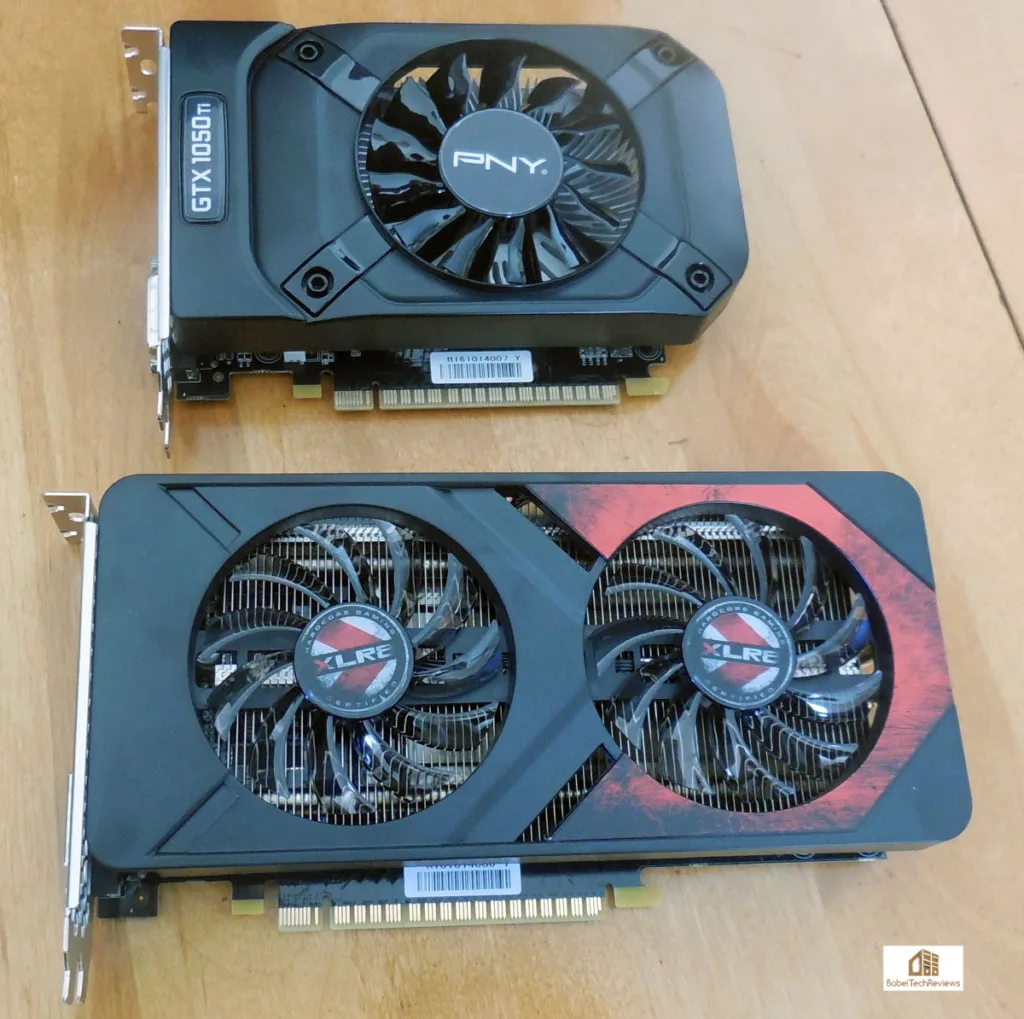
The AMD Polaris RX 460 arrived in August as a 2GB or 4GB 75W card on 14nm FinFET that now sells beginning at $99, depending on its vRAM capacity and core speeds. AMD has concentrated on launching the medium to low end while Nvidia began with the high end GTX 1080 and has moved down to the low end. The natural comparison we will make is between the $149 reference clocked PNY GTX 1050 Ti 4GB card versus the factory overclocked $149 XFX RX 460.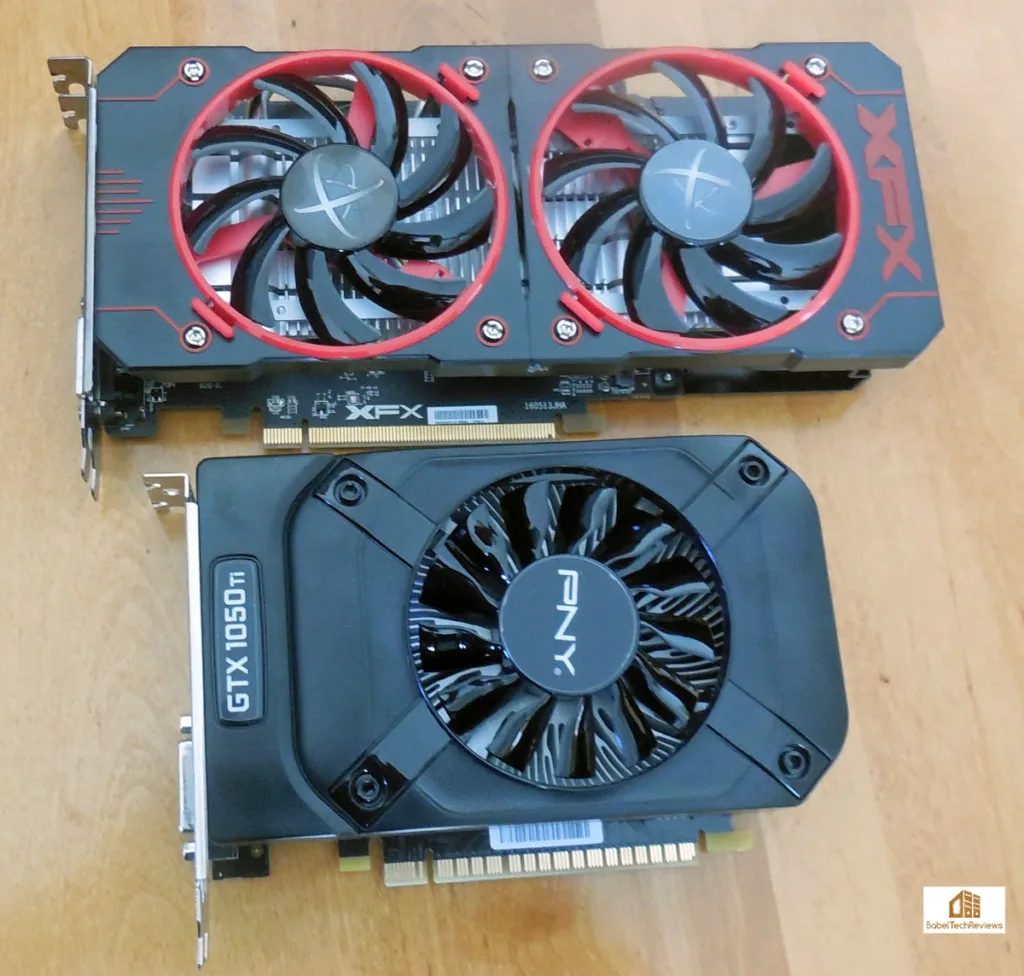
Now it’s Nvidia’s turn to launch their two new entry level GeForce gaming cards starting at $109 for the GTX 1050 and $139 for the GTX 1050 Ti today from Nvidia’s add-in card partners. For this evaluation, we are going to focus on the two PNY GTX 1050 Ti cards. This time there are no GTX 1050/Ti Founders Editions, and for a change, the 135 square mm GP107 GPU die is fabbed at Samsung on their 14nm process instead of at TSMC at 16nm as are the rest of the Pascal cards.
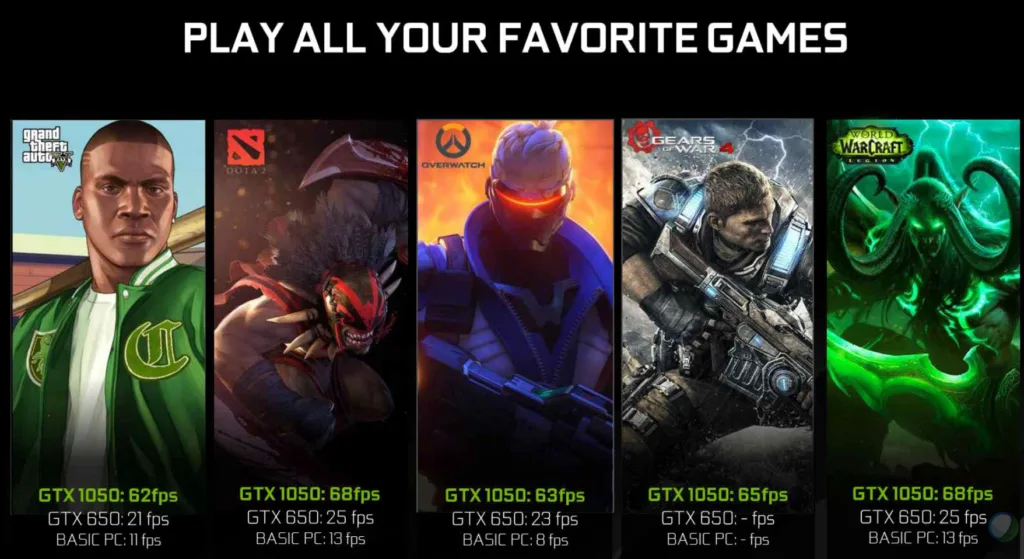 Nvidia suggests that the new GTX 1050 offers 3 times the performance of the Maxell GTX 650 as shown above. Both the GTX 1050 and the GTX 1050 Ti are 75W cards that do not require a PCIe connector as an easy upgrade for gamers with a 300W power supply. The PNY GTX 1050 Ti does not use any PCIe connector while both the XFX RX 460 and the PNY GTX 1050 Ti XLR8 OC edition use a single 6-pin connector.
Nvidia suggests that the new GTX 1050 offers 3 times the performance of the Maxell GTX 650 as shown above. Both the GTX 1050 and the GTX 1050 Ti are 75W cards that do not require a PCIe connector as an easy upgrade for gamers with a 300W power supply. The PNY GTX 1050 Ti does not use any PCIe connector while both the XFX RX 460 and the PNY GTX 1050 Ti XLR8 OC edition use a single 6-pin connector.
Nvidia illustrates the efficacy of upgrading a video card versus the costs of upgrading a 3-year old PC using only Intel CPU graphics below.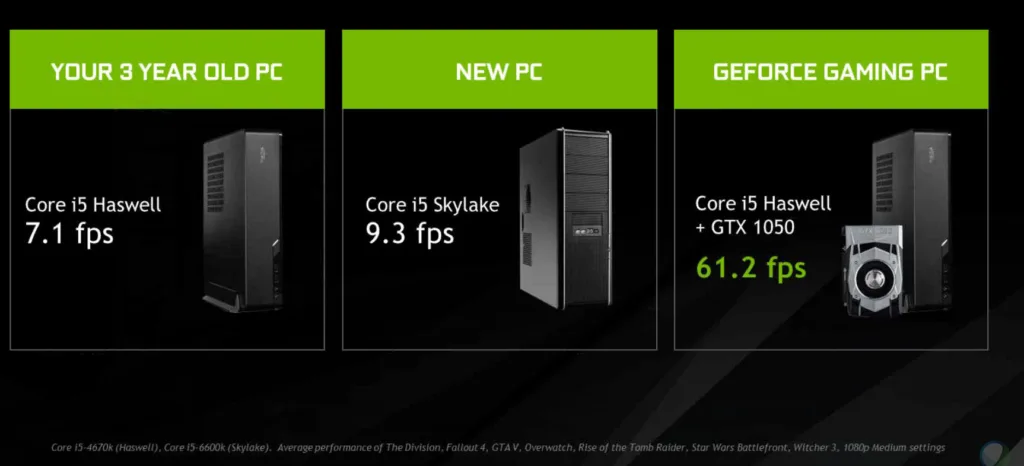
The low end or entry-level market is quite important to both AMD and Nvidia as PC gaming is growing fast, and more than half of all video games released in the USA are released on PC compared with the other half which are shared by the PS4 and the XBox One consoles. Part of this resurgence in PC gaming is fueled by eSports and the availability of inexpensive but quality video card for the most popular resolution, 1920×1080.
Specifications
The GTX 1050 2GB
Although we have not received a GTX 1050, it features 640 CUDA cores, 2GB of GDDR5 memory on a 128-bit bus running at 7Gbps, and a boost clock of 1.45GHz. 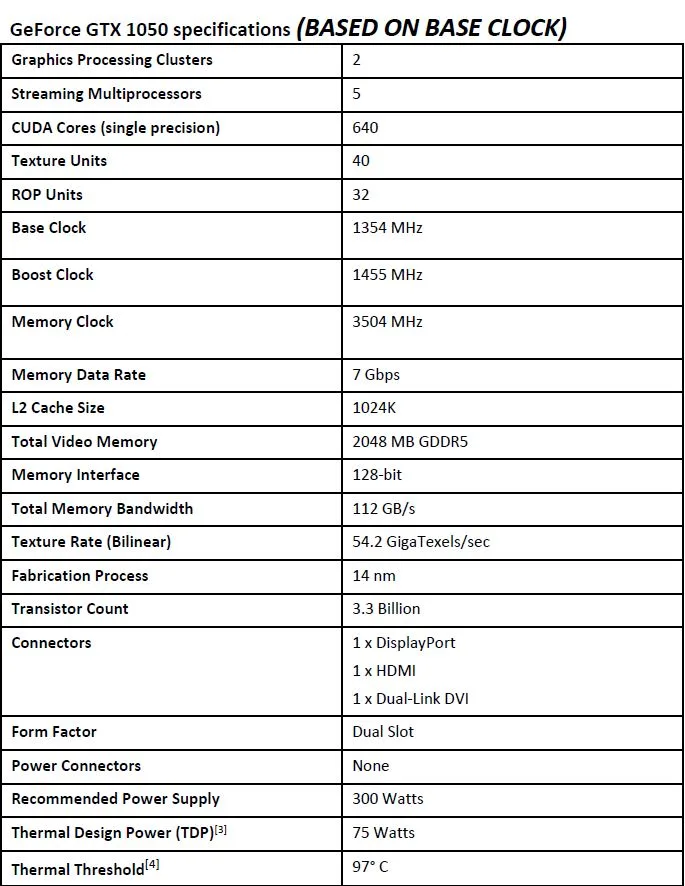
PNY offers a GTX 1050 2GB version which is priced ten dollars over the base GTX 1050 at $119.00 and it uses the reference clocks.
The GTX 1050 uses no extra power cable making it ideal for games with small capacity power supply units (PSU) and it is a good upgrade for GTX 750 Ti users. However, we are going to compare the performance of the GTX 750 Ti with the reference clocked PNY GTX 1050 Ti to see if it is a worthwhile upgrade at $149 as both cards draw their power only from the PCIe slot.

The GTX 1050 Ti
The GTX 1050 Ti features 768 CUDA cores, the same memory configuration as the GTX 1050, and it is clocked at 1.35GHz. Some partner cards will use a 6-pin PCIe connector for overclocking as PNY does for its GTX 1050 Ti XLR8 Overclocked Editon, and evidently some of the GTX 1050s will clock to 1.9GHz.
Here are the specifications for the PNY GTX 1050 Ti 4GB standard edition which is priced at $149. As you can see, it uses GTX 1050 reference clocks.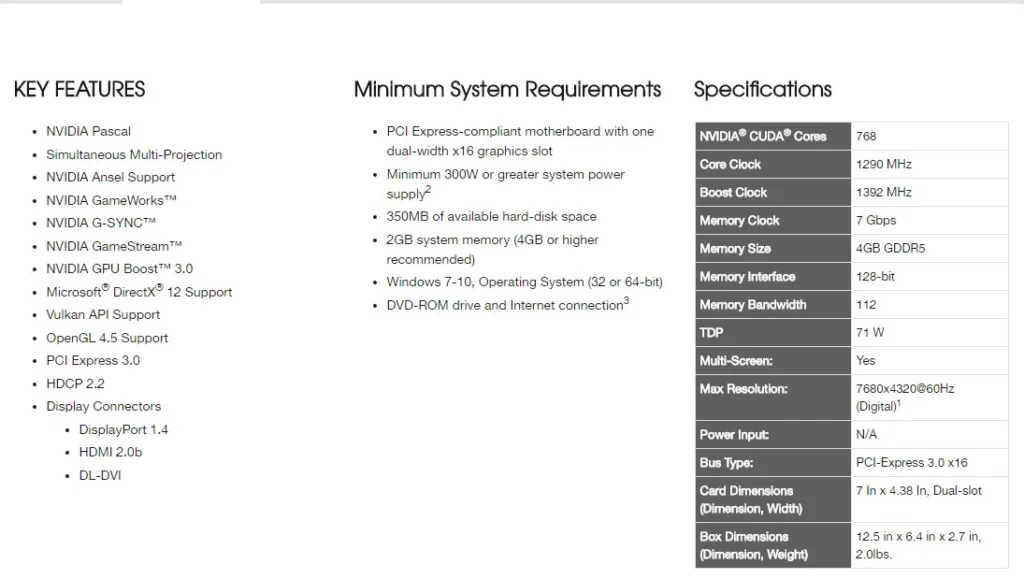
Here are the specifications for the PNY GTX 1050 Ti XLR8 Overclocked Gaming edition which is priced at $159.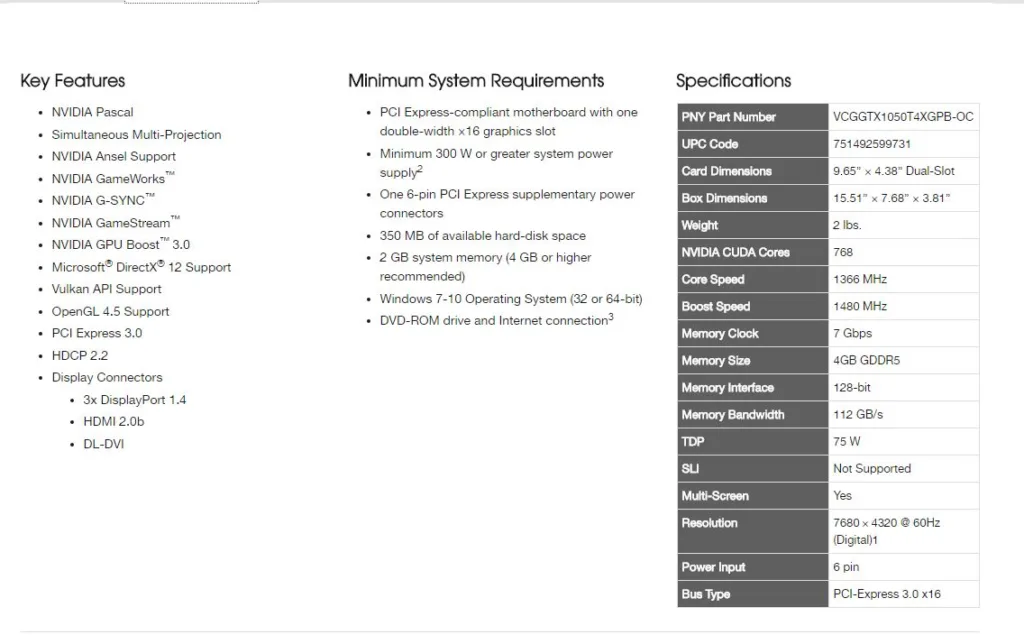
The PNY GTX 1050 Ti base clock is at 1366MHz core clock which is 76MHz over Nvidia’s reference clocks, and the Boost is 1480MHz, which is clocked 88MHz over Nvidia’s guaranteed boost, and it is priced $20 over Nvidia’s entry level pricing for the base GTX 1050 Ti.
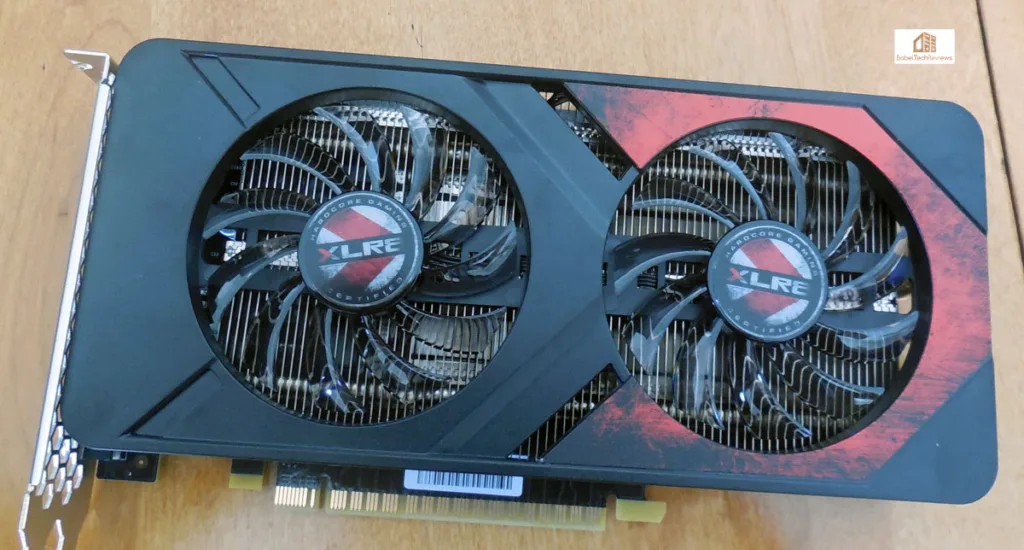
Like all of the other Pascal cards, the GTX 1050 and the GTX 1050 Ti include support for all of Nvidia’s Pascal features including Simultaneous Multi-Projection technology, which allows them to seamlessly project a single image simultaneously to both eyes. And like the other more expensive Pascal cards, the GTX 1050/1050 Ti can support using up to four displays simultaneously.
The GTX 1050 and the GTX 1050 Ti also supports Nvidia Ansel technology, a game-capture tool that allows gamers to explore and share gaming art in new ways. With Ansel, users can compose their gameplay shots by pointing the camera in any direction and from any vantage point within a gaming world, and then capture 360-degree stereo photospheres for viewing with a VR headset or with Google Cardboard. For a recap of Nvidia’s Pascal architecture see our GTX 1060 Founders Edition launch article.
The $149 PNY GeForce GTX 1050 4GB & the $159 GTX 1050 Ti XLR8 OC vs. the factory overclocked $149 XFX RX 460
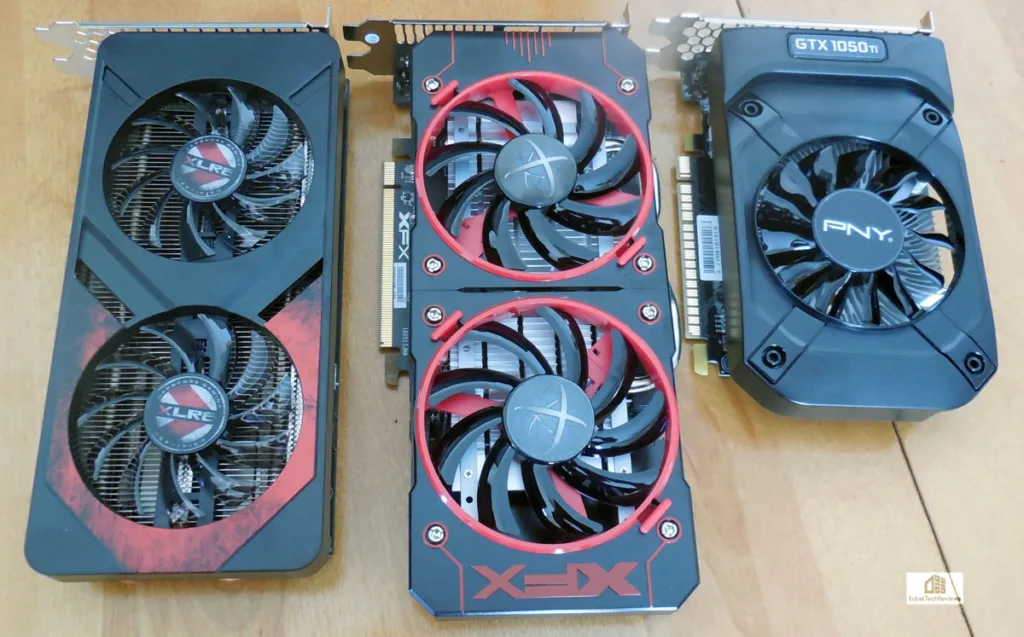
AMD is evidently dropping the pricing on the RX 460 to $99 for the entry-level base 2GB cards and to $169 for the base RX 470 in advance of the release of the GTX 1050s. However, AMD’s premium overclocked partner cards’ pricing has mostly remained the same on Newegg with some softening in the form of mail in rebates. All of these cards have low power requirements and are aimed at the HTPC or small form factor PC enthusiast as well as at the gamer on a tight budget. The GTX 1050 and the PNY GTX 1050 Ti 4GB edition have no power connector and are aimed at enthusiasts with low power PSUs. The GTX 1050 and GTX 1050 Ti are also aimed at 1920×1080 resolution and especially at the eSports gamers.
Our Big Picture Test bed of Competing Cards
This evaluation is focused on performance, and we will especially compare the PNY GTX 1050 Ti 4GB and the XLR8 Overclocked Gaming edition against the XFX RX 460 4GB overclocked edition. We will also compare the performance of 6 other competing video card configurations including the GTX 1060 3GB, the GTX 960 2GB OC, the GTX 950 2GB OC, the GTX 750 Ti, the GTX 1060 3GB, and the RX 470 to determine where the new PNY GTX 1050 Tis fit in terms of performance vs pricing.
Our testing platform is Windows 10 Home 64-bit, using an Intel Core i7-6700K at 4.00GHz which turbos to 4.4GHz for all cores as set in the ASRock Z7170 motherboard’s BIOS, and 16GB of G.SKILL DDR4 at 3000MHz. The settings and hardware are identical except for the drivers being tested.
We test 28 games and 2 synthetics featuring our newest 2016 games, Shadow Warrior 2 and Civilization VI, and we are also including Ashes of the Singularity, Hitman, Total War Warhammer, Gears of War 4, and Rise of the Tomb Raider using DX12. We have also added Futuremark’s DX12 benchmark, Time Spy, and will compare gaming performance with maximum settings at 1920×1080.
Here is our test bed:
- PNY GTX 1050 Ti XLR8 OC Edition – $159
- PNY GTX 1050 Ti 4GB – $149
- EVGA GTX 1060 3GB – $199
- ASUS Strix GTX 950 OC 2GB – $137
- ASUS Strix GTX 960 OC 2GB – $159
- PowerColor Red Devil RX 470 4GB – $184
- XFX RX 460 4GB – $149
Let’s take a closer look at the new PNY GTX 1050 Ti 4GB and the GTX 1050 Ti XLR8 Overclocked Gaming Edition.
Unboxing the PNY GTX 1050 Ti 4GB
The PNY GTX 1050 Ti 4GB comes in a small box. The front of the box features the GTX 1060’s 4GB GDDR5, and that it uses Game Ready Drivers, features GameWorks and DX12.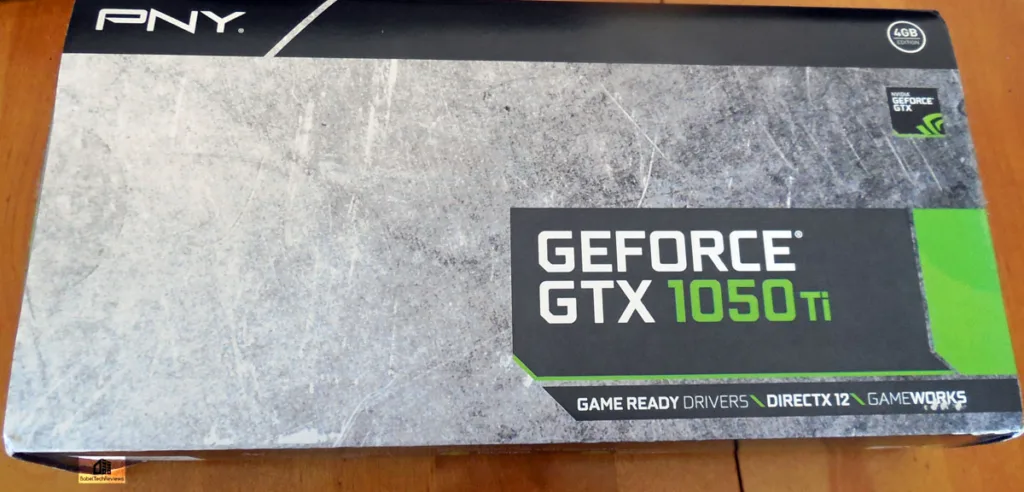
The sides and back of the box advertise its key features, as well as advise you to “Plug in the Power of PNY”.
The PNY warranty is 3 years on both of these cards.
Here is everything out of the box.The card is packed securely and it comes in an anti-static clamshell. It comes with a quick start quide and a driver CD.
The PNY GTX 1050 is a good looking short single-fan card with a plastic shroud that covers a basic heatsink. 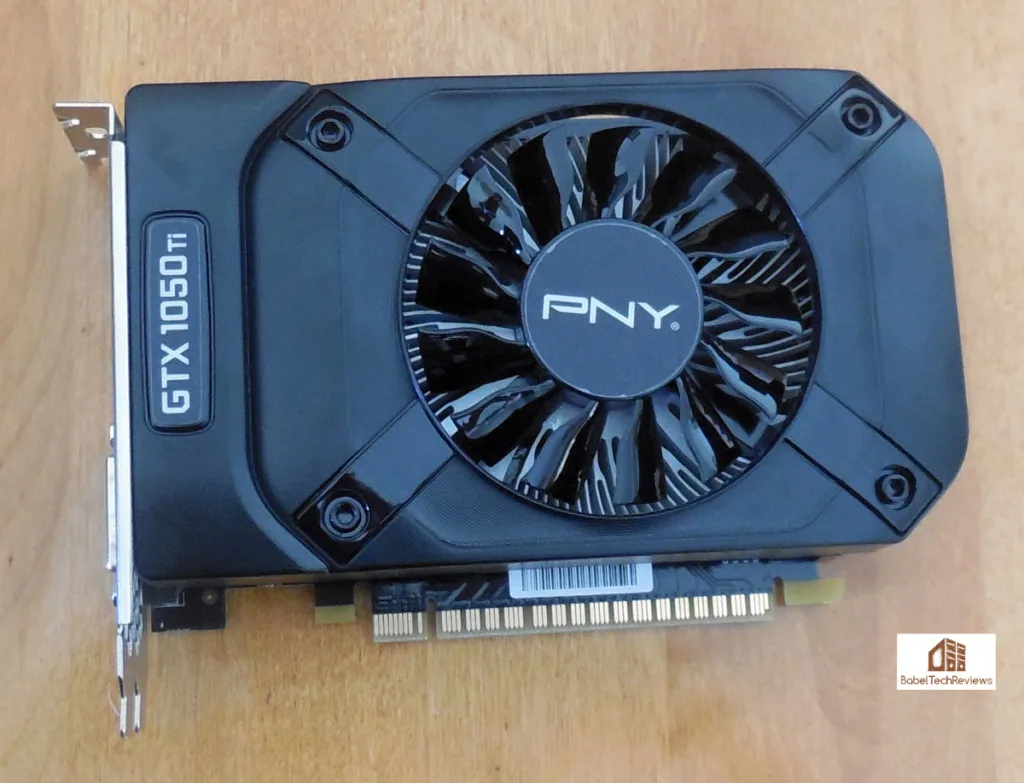
We turn the card on its edge and look at the cooling fins which allow the card to fit into a PC motherboard’s double slot configuration. The heatsink area is quite large for a very small card. All of the power is drawn from the PCIe slot, there is no PCIe connector.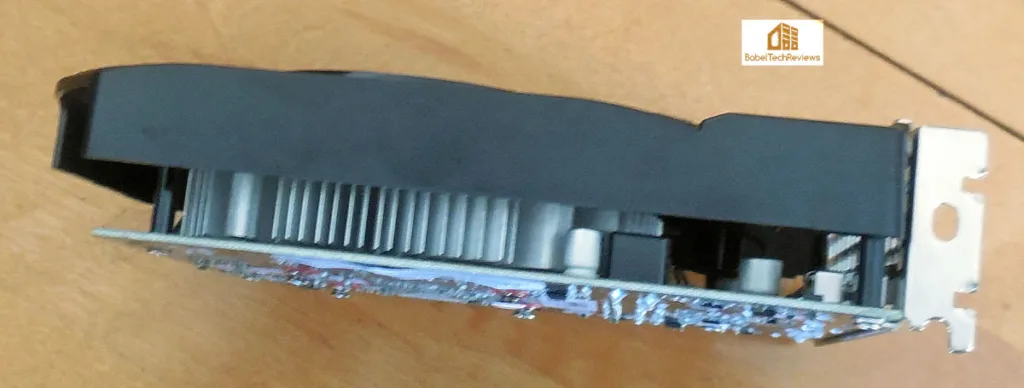
None of PNY GTX 1050 Ti video cards have a backplate.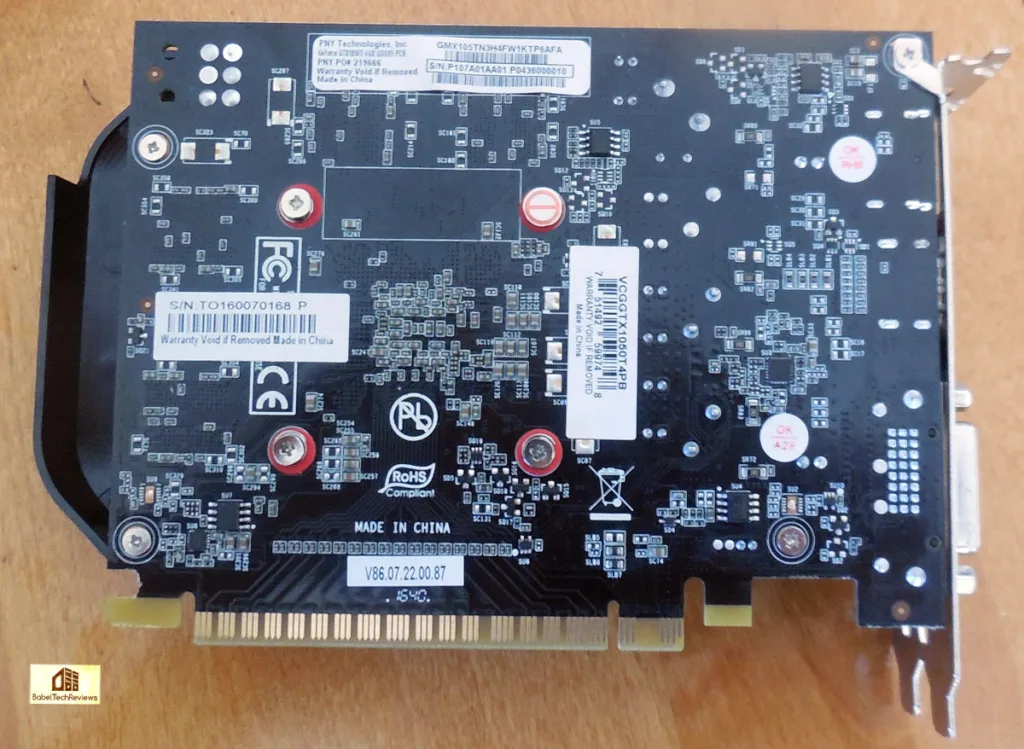
Here is the connector panel.There are one dual link DVI port, 1 Display Port and a HDMI 2.0 port. 
The PNY GTX 1050 is a good looking low-power small card and the specifications look very good. Let’s check out it’s bigger brother, the XLR8 Overclocked Gaming Edition.
Unboxing the PNY GTX 1050 Ti XLR8 Overclocked Gaming edition
The PNY GTX 1050 Ti XLR8 Overclocked edition came to us for evaluation in a plain box which does not represent the retail version so we will not show it.
Here is everything included in the box.The card is packed securely and it comes in an anti-static clamshell. It comes with a quick start guide, and a driver installation CD. Also included is a dual molex to 6-pin PCIe cable.
The PNY GTX 1050 Ti XLR8 Overclocked edition is a handsome short dual-fan card that covers a large radiator. The large fan spins relatively slowly compared with a single fan or a blower. Two slower-turning fans will remove the GPU’s heat better and more quietly, compared with a double speed single fan used in the reference-clocked version. Both PNY GTX 1050 Tis are quiet in operation.
 We turn the card on its edge and look at the slim design cooling fins which allow the card to fit into a PC motherboard’s double slot configuration. The heatsink area is quite large for a very small card. Besides drawing the power from the PCIe slot, there is one 6-pin connector.
We turn the card on its edge and look at the slim design cooling fins which allow the card to fit into a PC motherboard’s double slot configuration. The heatsink area is quite large for a very small card. Besides drawing the power from the PCIe slot, there is one 6-pin connector.
Neither of PNY GTX 1050 Ti edition video cards have a backplate.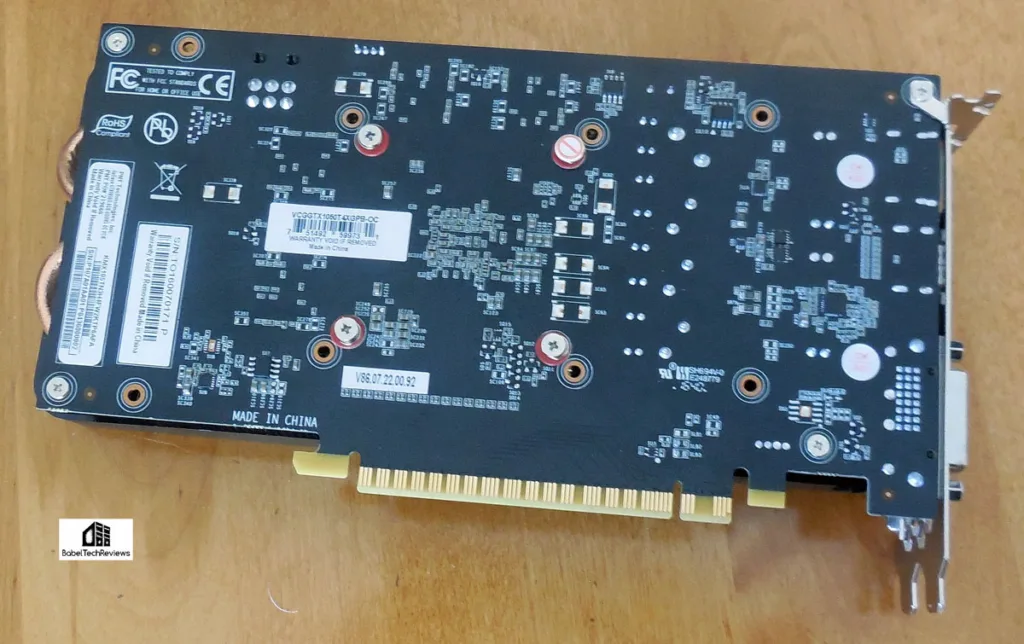
Here is the connector panel. As with the other reference clocked PNY GTX 1050 Ti, there are one dual link DVI port, 1 Display Port and a HDMI 2.0 port. 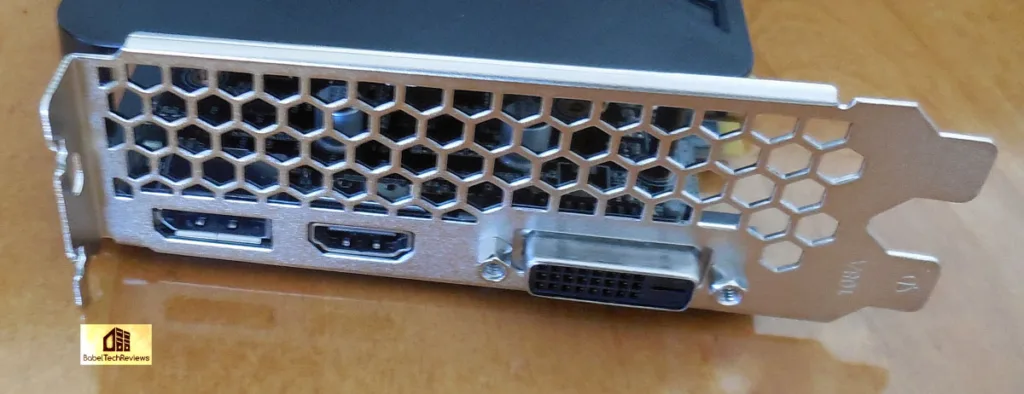
The PNY GTX 1050 Ti XLR8 Overclocked edition is a handsome small card and the specifications look very good.
Let’s check out our two PNY GTX 1050 Tis’ performance versus the XFX RX 460 4GB card after we look over our test configuration on the next page.
Test Configuration – Hardware
- Intel Core i7-6700K (reference 4.0GHz, HyperThreading and Turbo boost is on to 4.4GHz; DX11 CPU graphics).
- ASRock Z7170M OC Formula motherboard (Intel Z7170 chipset, latest BIOS, PCIe 3.0/3.1 specification, CrossFire/SLI 8x+8x)
- HyperX 16GB DDR4 (2x8GB, dual channel at 3333MHz)
- PNY GTX 1050 Ti XLR8 Overclocked edition 4GB, PNY clocks, supplied by PNY
- PNY GTX 1050 Ti 4GB, stock clocks, supplied by PNY
- EVGA GTX 1060 3GB, stock clocks, supplied by EVGA
- ASUS Strix GTX 950 GB OC 2GB, ASUS factory clocks, supplied by ASUS
- ASUS Strix GTX 960 GB OC 2GB, ASUS factory clocks, supplied by ASUS
- GTX 750 Ti 2GB, reference clocks, supplied by Nvidia
- XFX RX 460 4GB, XFX factory clocks
- PowerColor Red Devil RX 470 4GB, at PowerColor factory clocks, supplied by PowerColor
- Two 2TB Toshiba 7200 rpm HDDs for each platform
- EVGA 1000G 1000W power supply unit
- Thermaltake Water2.0, supplied by Thermaltake
- Onboard Realtek Audio
- Genius SP-D150 speakers, supplied by Genius
- Thermaltake Overseer RX-I full tower case, supplied by Thermaltake
- ASUS 12X Blu-ray writer
- Monoprice Crystal Pro 4K
Test Configuration – Software
- Nvidia’s GeForce 375.57 used for all of the Nvidia cards. High Quality, prefer maximum performance, single display.
- AMD Crimson Software 16.10.2 drivers were used for benching AMD cards.
- VSync is off in the control panel.
- AA enabled as noted in games; all in-game settings are specified with 16xAF always applied
- All results show average frame rates including minimum frame rates shown in italics on the chart next to the averages in smaller font.
- Highest quality sound (stereo) used in all games.
- Windows 10 64-bit Home edition, all DX11 titles were run under DX11 render paths. Our four DX12 titles are run under the DX12 render path. Latest DirectX
- All games are patched to their latest versions at time of publication.
- Crimson Software’s WattMan was used for the RX 480 and the RX 470 to set the Power Limits to maximum.
- EVGA’s Precision XOC, reviewer’s version 6 used for Nvidia cards to set the overclock and the Power/Temp targets to maximum.
- Unigine Heaven 4.0 was used to set preliminary overclocks
Synthetic
- Firestrike – Ultra & Extreme
- Time Spy DX12
- Crysis 3
- Metro: Last Light Redux (2014)
- Middle Earth: Shadows of Mordor
- Alien Isolation
- Dragon’s Age: Inquisition
- Dying Light
- Grand Theft Auto V
- ProjectCARS
- the Witcher 3
- Batman: Arkham Origins
- Mad Max
- Fallout 4
- Star Wars Battlefront
- Assassin’s Creed Syndicate
- Just Cause 3
- Rainbow Six Siege
- DiRT Rally
- Far Cry Primal
- Tom Clancy’s The Division
- DOOM (*OpenGL for Nvidia Cards)
- Mirror’s Edge Catalyst
- Deus Ex Mankind Divided
- Shadow Warrior 2
- Civilization VI
DX12 Games
- Ashes of the Singularity
- Hitman
- Rise of the Tomb Raider
- Total War: Warhammer
- Gears of War 4
Nvidia’s Control Panel settings:
Here are the settings that we always use in AMD’s Crimson Control Center for our default benching. The Power Efficiency Toggle is left off in our benching.
Lets see how the PNY GTX 1050 Ti XLR8 4GB and GTX 1050 Ti 4GB compares with the XFX RX 460, and with the other similarly priced competing cards of Summer, 2016.
Performance summary charts
All of our testing is at 1920×1080 resolution for which these cards were designed. To be consistent across all of our benching, we use maximum settings.
All results except for Firestrike and Timespy are expressed in average fps (in Bold) and also generally in minimum fps (where they make sense, in italics below the averages).
The stock PNY GTX 1050 Ti 4GB performance results are in Column 1 and it’s main competitor the XFX RX 460 4GB OC version performance results are in the second column. The third column shows the performance of the PNY GTX 1050 Ti XLR8 Overclocked Gaming edition. The fourth column shows the reference GTX 750 Ti results. The fifth and sixth column show the performance of the last generation ASUS Strix GTX 950 OC and GTX 960 OC results, and the seventh and eight columns compare the PowerColor-clocked RX 470 with the reference clocked EVGA GTX 1060 3GB.
Make sure to open this chart in another window or in a separate tab for better readability.




 As you can see, the stock-clocked $149 PNY GTX 1050 Ti 4GB blows away the $149 factory clocked XFX RX 460. It isn’t even close except in Deus Ex Mankind Divided and perhaps in Hitman. We also see that the $159 PNY GTX 1050 Ti XLR8 OC Gaming edition is generally more than 10% faster than the standard PNY GTX 1050 Ti 4GB, and the performance gap widens into a chasm over the XFX RX 460.
As you can see, the stock-clocked $149 PNY GTX 1050 Ti 4GB blows away the $149 factory clocked XFX RX 460. It isn’t even close except in Deus Ex Mankind Divided and perhaps in Hitman. We also see that the $159 PNY GTX 1050 Ti XLR8 OC Gaming edition is generally more than 10% faster than the standard PNY GTX 1050 Ti 4GB, and the performance gap widens into a chasm over the XFX RX 460.
The older generation GTX 950 card, although factory overclocked by ASUS, are easily bested by the standard GTX 1050 Ti as is the GTX 960 OC bested by the PNY GTX 1050 Ti XLR8. We see the GTX 750 Ti – a very popular low power card – is really showing its age and we think the new GTX 1050 Ti which is just as low power, will make a very good upgrade for gamers with small capacity PSUs.
The stock clocked EVGA GTX 1060 3GB and the PowerColor Red Devil RX 470 are in a higher class entirely as they are priced in the $185-$200 range.
Let’s head for our conclusion.
The Conclusion
We have no trouble giving a big recommendation to the PNY GTX 1050 Ti and especially to the XLR8 Overclocked Gaming Edition for $10 more as it gives better than 10% more performance. Both cards are small, they look great, run cool and are very quiet, and their out of the box performance is significantly higher than the competing XFX RX 460 for the same $149 price. The PNY cards win all of our benchmarks over the RX460.
The main reason in our opinion to choose the regularly clocked $149 PNY GTX 1050 Ti 4GB version over the $159 XLR8 is if you need a shorter card that does not require a PCIe connector. Other than that, we would always pick the XLR8 for its higher performance. We would not pick a 2GB card any longer for even 1920×1080 as we see our older GTX 960 and GTX 950 have issues with some modern games because of their limited vRAM capacities.
We did not get to overclock either of our GTX 1050 Tis because of the very limited time we had to evaluate them, and we will follow up later this week with a manual overclocking evaluation comparing both of our PNY cards with the XFX RX 460. We expect that the XLR8 version will overclock better than the standard PNY GTX 1050 Ti by virtue of its better cooling and higher power draw potential.
PNY GTX 1050 Ti 4GB & XLR8 OC Edition Pros
- Both PNY GTX 1050 Tis beat the XFX RX 460 decisively in performance at a similar price.
- With none or with one 6-pin PCIe connector, TDP and power draw are good and they are very quiet in operation
- The no-PCIe connector PNY GTX 1050 Ti fits into a smaller space than competing cards and it absolutely blows away the GTX 750 Ti performance.
- The card are well-built and look great.
- The GeForce Experience and GameWorks, including ShadowPlay, enhance the gaming experience. G-SYNC helps to smooth gaming framerates by syncing the display to the GPU and it allows for smooth framerates without stuttering or tearing.
- PNY has excellent support and a 3 year warranty for these cards.
Cons
- None.
 The Verdict:
The Verdict:
- If you are buying a video card right now and looking for good performance at 1920×1080, either of the PNY GTX 1050 Tis are excellent choices. They beat their Radeon RX 460 competition while using less power.
- We would choose the PNY GTX 1050 Ti standard edition for 1920×1080 gaming where space and power considerations are tight. For higher performance, we would choose the GTX 1050 Ti XLR8 Overclocked Gaming Edition.
- We would like to award both of the PNY GTX 1050 Tis BTR’s Editor’s Choice Award
We do not know what the future will bring, but the PNY GTX 1050 Ti 4GB and the GTX 1050 Ti XLR8 Overclocked Gaming edition brings excellent performers to the Pascal GeForce family, and they clearly establish themselves as having excellent value for 1920×1080 gaming.
If you currently game on an older generation video card, you will do yourself a big favor by upgrading. The move to a PNY GTX 1050 Ti will give you better visuals on the DX11 and DX12 pathways and they are both faster than the RX 460 in the same price range And we will follow this evaluation up with an overclocked evaluation.
AMD offers their own set of features including Vulkan, Eyefinity 2.0, and FreeSync, but their Polaris RX 460 as represented by the factory overclocked XFX RX 460 card, simply cannot match the performance of even the GTX 1050 Ti at stock clocks.
Stay tuned, there is a lot coming from us at BTR. We are going to evaluate an EVGA GTX 1050 Ti this week and we will put all of the competing cards into an Overclocked Showdown. We also have a HyperX Cloud Stinger headset up for evaluation this weekend.
Happy Gaming!
Mark Poppin
BTR Editor-in-Chief
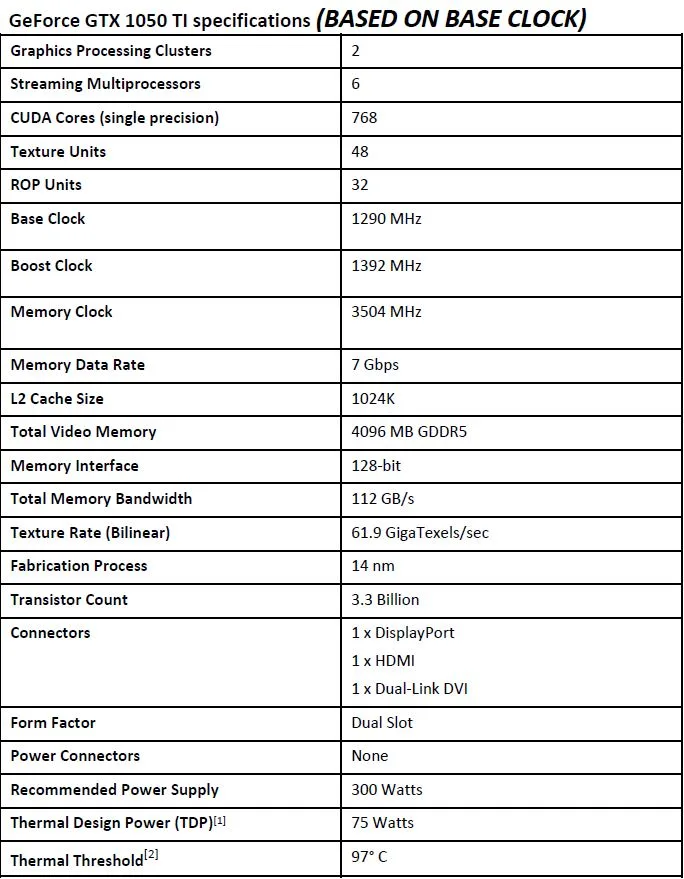
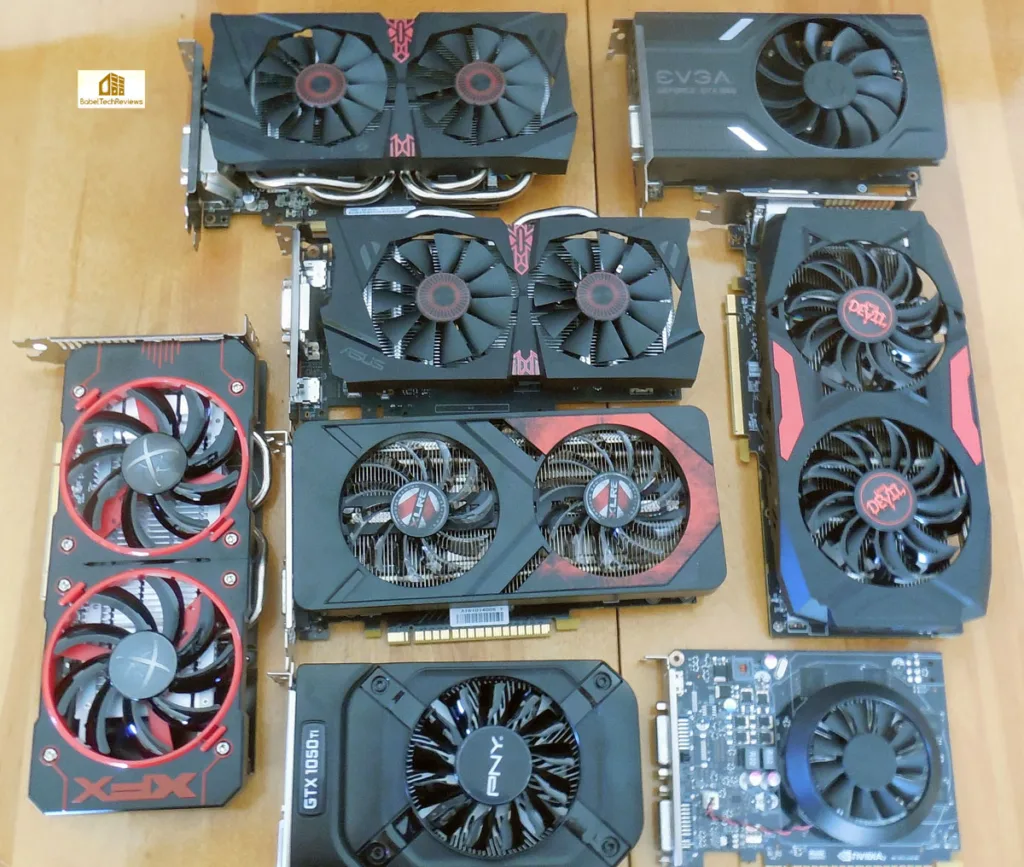
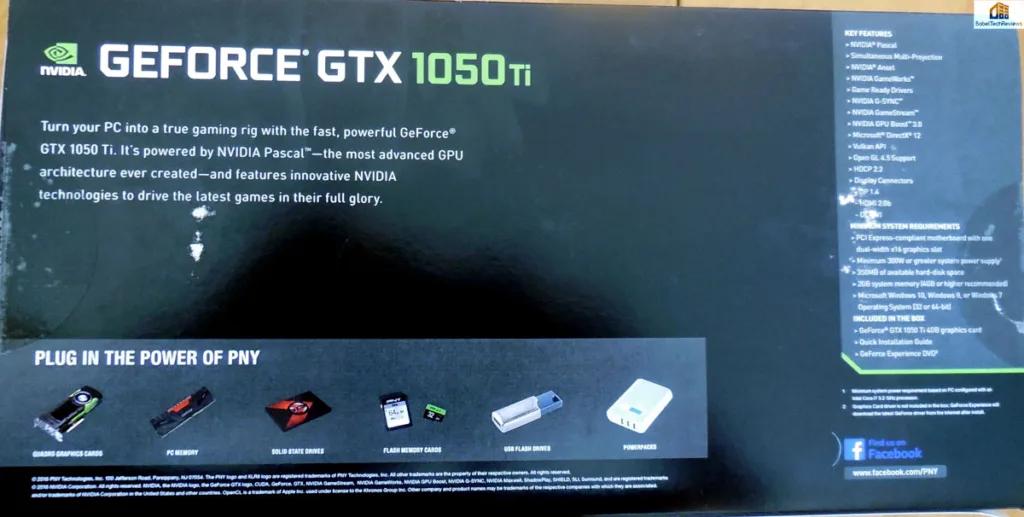


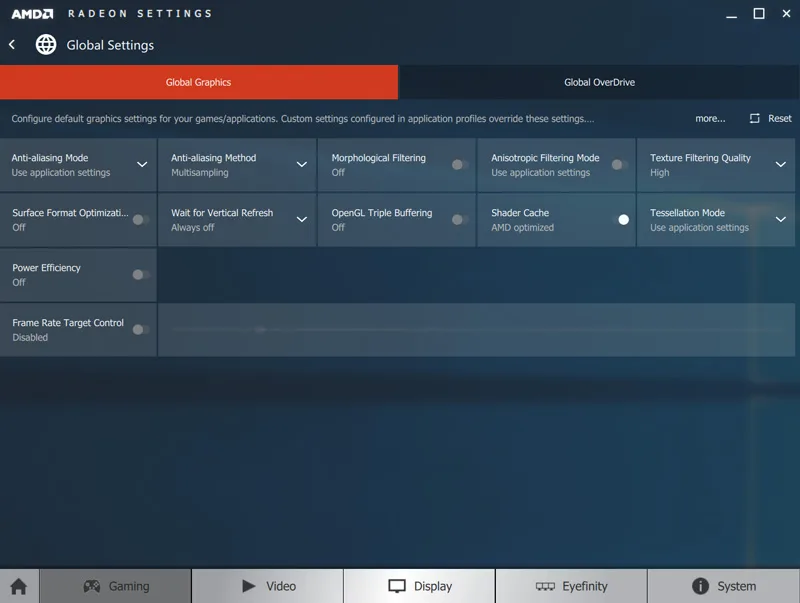
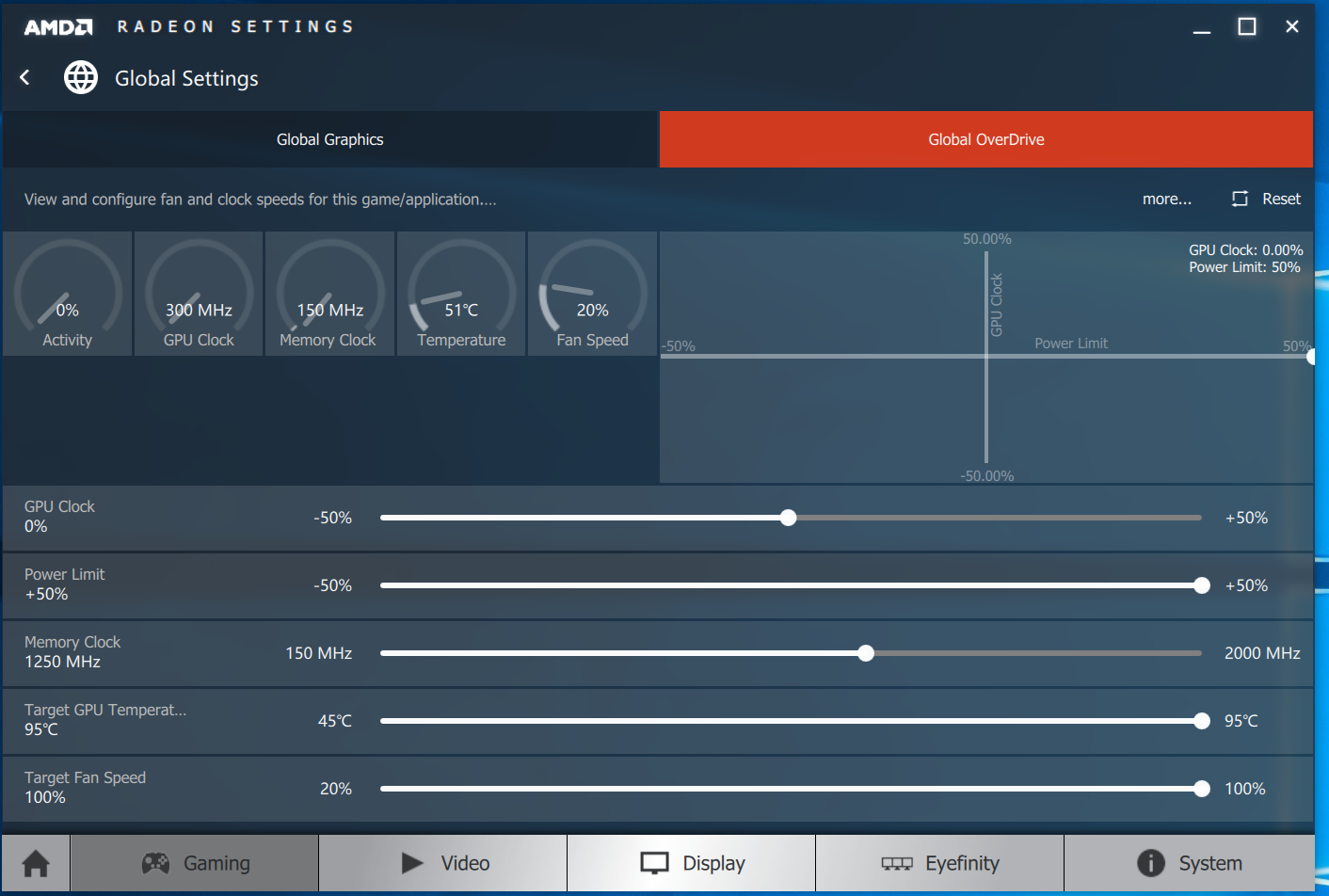
Comments are closed.